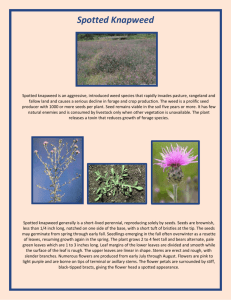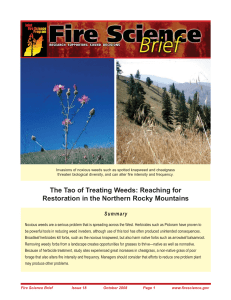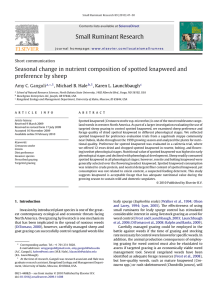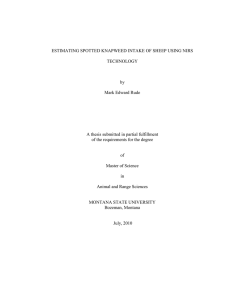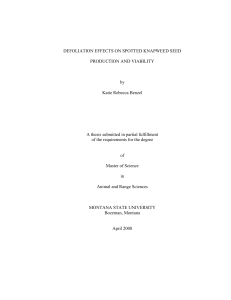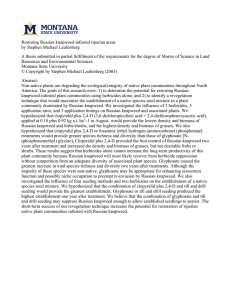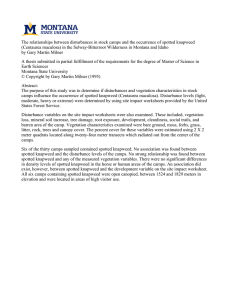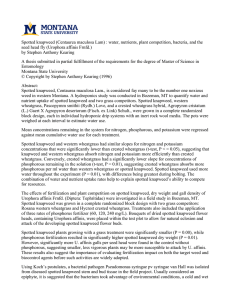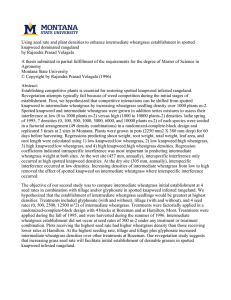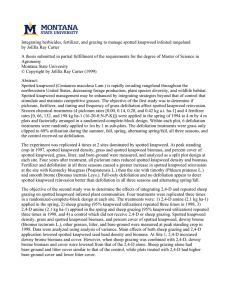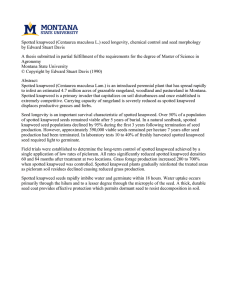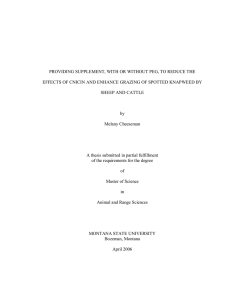Restoration of Native Plant Communities Infested by Invasive Weeds—Sawmill Creek Peter Rice
advertisement
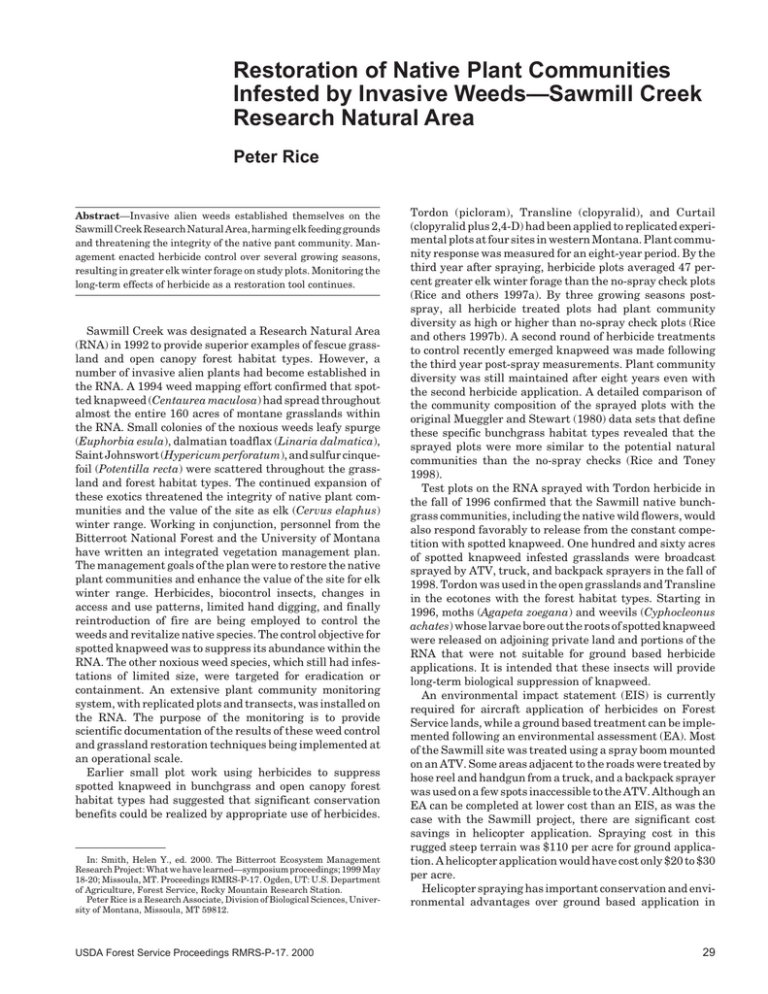
Restoration of Native Plant Communities Infested by Invasive Weeds—Sawmill Creek Research Natural Area Peter Rice Abstract—Invasive alien weeds established themselves on the Sawmill Creek Research Natural Area, harming elk feeding grounds and threatening the integrity of the native pant community. Management enacted herbicide control over several growing seasons, resulting in greater elk winter forage on study plots. Monitoring the long-term effects of herbicide as a restoration tool continues. Sawmill Creek was designated a Research Natural Area (RNA) in 1992 to provide superior examples of fescue grassland and open canopy forest habitat types. However, a number of invasive alien plants had become established in the RNA. A 1994 weed mapping effort confirmed that spotted knapweed (Centaurea maculosa) had spread throughout almost the entire 160 acres of montane grasslands within the RNA. Small colonies of the noxious weeds leafy spurge (Euphorbia esula), dalmatian toadflax (Linaria dalmatica), Saint Johnswort (Hypericum perforatum), and sulfur cinquefoil (Potentilla recta) were scattered throughout the grassland and forest habitat types. The continued expansion of these exotics threatened the integrity of native plant communities and the value of the site as elk (Cervus elaphus) winter range. Working in conjunction, personnel from the Bitterroot National Forest and the University of Montana have written an integrated vegetation management plan. The management goals of the plan were to restore the native plant communities and enhance the value of the site for elk winter range. Herbicides, biocontrol insects, changes in access and use patterns, limited hand digging, and finally reintroduction of fire are being employed to control the weeds and revitalize native species. The control objective for spotted knapweed was to suppress its abundance within the RNA. The other noxious weed species, which still had infestations of limited size, were targeted for eradication or containment. An extensive plant community monitoring system, with replicated plots and transects, was installed on the RNA. The purpose of the monitoring is to provide scientific documentation of the results of these weed control and grassland restoration techniques being implemented at an operational scale. Earlier small plot work using herbicides to suppress spotted knapweed in bunchgrass and open canopy forest habitat types had suggested that significant conservation benefits could be realized by appropriate use of herbicides. In: Smith, Helen Y., ed. 2000. The Bitterroot Ecosystem Management Research Project: What we have learned—symposium proceedings; 1999 May 18-20; Missoula, MT. Proceedings RMRS-P-17. Ogden, UT: U.S. Department of Agriculture, Forest Service, Rocky Mountain Research Station. Peter Rice is a Research Associate, Division of Biological Sciences, University of Montana, Missoula, MT 59812. USDA Forest Service Proceedings RMRS-P-17. 2000 Tordon (picloram), Transline (clopyralid), and Curtail (clopyralid plus 2,4-D) had been applied to replicated experimental plots at four sites in western Montana. Plant community response was measured for an eight-year period. By the third year after spraying, herbicide plots averaged 47 percent greater elk winter forage than the no-spray check plots (Rice and others 1997a). By three growing seasons postspray, all herbicide treated plots had plant community diversity as high or higher than no-spray check plots (Rice and others 1997b). A second round of herbicide treatments to control recently emerged knapweed was made following the third year post-spray measurements. Plant community diversity was still maintained after eight years even with the second herbicide application. A detailed comparison of the community composition of the sprayed plots with the original Mueggler and Stewart (1980) data sets that define these specific bunchgrass habitat types revealed that the sprayed plots were more similar to the potential natural communities than the no-spray checks (Rice and Toney 1998). Test plots on the RNA sprayed with Tordon herbicide in the fall of 1996 confirmed that the Sawmill native bunchgrass communities, including the native wild flowers, would also respond favorably to release from the constant competition with spotted knapweed. One hundred and sixty acres of spotted knapweed infested grasslands were broadcast sprayed by ATV, truck, and backpack sprayers in the fall of 1998. Tordon was used in the open grasslands and Transline in the ecotones with the forest habitat types. Starting in 1996, moths (Agapeta zoegana) and weevils (Cyphocleonus achates) whose larvae bore out the roots of spotted knapweed were released on adjoining private land and portions of the RNA that were not suitable for ground based herbicide applications. It is intended that these insects will provide long-term biological suppression of knapweed. An environmental impact statement (EIS) is currently required for aircraft application of herbicides on Forest Service lands, while a ground based treatment can be implemented following an environmental assessment (EA). Most of the Sawmill site was treated using a spray boom mounted on an ATV. Some areas adjacent to the roads were treated by hose reel and handgun from a truck, and a backpack sprayer was used on a few spots inaccessible to the ATV. Although an EA can be completed at lower cost than an EIS, as was the case with the Sawmill project, there are significant cost savings in helicopter application. Spraying cost in this rugged steep terrain was $110 per acre for ground application. A helicopter application would have cost only $20 to $30 per acre. Helicopter spraying has important conservation and environmental advantages over ground based application in 29 addition to lower per acre treatment costs. Aircraft operator exposure to herbicide residues is lower than for ground vehicle and backpack sprayer crews. Large blocks can be sprayed very quickly when weather conditions and plant growth stages are optimal for spraying. A narrow window of opportunity with the most favorable conditions can be used to reduce drift, maximize efficacy on target weeds, and minimize herbicide injury to desirable plants. Normal use of the site by wildlife and recreationists is disrupted less by compressing the duration of treatment activities. Sawmill could have been helicopter sprayed in less than half a day. The ground-based work took 36 days. Elk are quickly attracted to the enhanced grazing conditions in the herbicide sprayed areas of knapweed degraded winter ranges. The elk exhibit a strong early spring selection preference for these newly vigorous bunchgrasses. If too small an area is sprayed, the concentration of elk may negate some of the benefit of treatment and slow recovery of the native plants. Cost effective treatment of larger blocks should help disperse grazing elk during the initial years of recovery of the bunchgrass communities from competition with knapweed. The Sawmill RNA Project demonstrates that appropriate use of herbicides can provide clear benefits in the restoration of native plant communities and the enhancement of the wildlife value of montane grasslands. The Ravalli County Weed District, adjacent private land owners, Rocky Mountain Elk Foundation, Stewart Spraying, 30 Western Agricultural Research Center, University of Montana, Rocky Mountain Research Station, and the Bitterroot National Forest cooperated in the design, funding, and implementation of this restoration project. Now that the weeds are suppressed it is possible to reintroduce fire to both the grassland and forested areas of the site without increasing the weed problem. Response monitoring will continue beyond the year 2000. Experience gained on this project can serve as a model for the restoration of other high conservation value sites that are being degraded by invasive weeds. References _____________________ Rice, P.M.; Toney, J.C. 1998. Exotic weed control treatments for conservation of fescue grassland in Montana. Biological Conservation. 85: 83-95. Rice, P.M.; Toney, J.C.; Bedunah, D.J; Carlson, C.E. 1997a. Elk winter forage enhancement by herbicide control of spotted knapweed. Wildlife Society Bulletin. 25(3): 627-633. Rice, P.M.; Toney, J.C.; Bedunah, D.J.; Carlson, C.E. 1997b. Plant community diversity and growth form responses to herbicide applications for the control of Centaurea maculosa. Journal of Applied Ecology. 34: 1397-1412. Rice, P.M.; Toney, J.C. 1996. Plant population response to broadcast herbicide applications for spotted knapweed control. Down To Earth. 51(2): 14-19. Rice, P.M.; Bedunah, D.J.; Carlson, C.E. 1992. Plant community diversity after herbicide control of spotted knapweed. Res. Pap. INT-460. Ogden, UT: U.S. Department of Agriculture, Forest Service, Intermountain Research Station. 7 p. USDA Forest Service Proceedings RMRS-P-17. 2000

